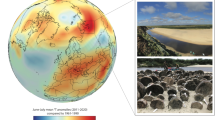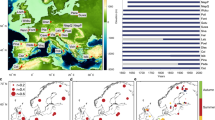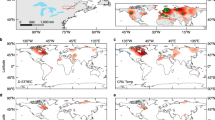Abstract
Solar insolation changes, resulting from long-term oscillations of orbital configurations1, are an important driver of Holocene climate2,3. The forcing is substantial over the past 2,000 years, up to four times as large as the 1.6 W m−2 net anthropogenic forcing since 1750 (ref. 4), but the trend varies considerably over time, space and with season5. Using numerous high-latitude proxy records, slow orbital changes have recently been shown6 to gradually force boreal summer temperature cooling over the common era. Here, we present new evidence based on maximum latewood density data from northern Scandinavia, indicating that this cooling trend was stronger (−0.31 °C per 1,000 years, ±0.03 °C) than previously reported, and demonstrate that this signature is missing in published tree-ring proxy records. The long-term trend now revealed in maximum latewood density data is in line with coupled general circulation models7,8 indicating albedo-driven feedback mechanisms and substantial summer cooling over the past two millennia in northern boreal and Arctic latitudes. These findings, together with the missing orbital signature in published dendrochronological records, suggest that large-scale near-surface air-temperature reconstructions9,10,11,12,13 relying on tree-ring data may underestimate pre-instrumental temperatures including warmth during Medieval and Roman times.
This is a preview of subscription content, access via your institution
Access options
Subscribe to this journal
Receive 12 print issues and online access
$209.00 per year
only $17.42 per issue
Buy this article
- Purchase on Springer Link
- Instant access to full article PDF
Prices may be subject to local taxes which are calculated during checkout



Similar content being viewed by others
References
Milankovitch, M. Kanon der Erdbestrahlung und seine Anwendung auf das Eiszeitenproblem. (Königlich Serbische Akademie, 1941).
Wanner, H. et al. Mid- to late Holocene climate change: An overview. Quat. Sci. Rev. 27, 1791–1828 (2008).
Mayewski, P. A. et al. Holocene climate variability. Quat. Res. 62, 243–255 (2004).
IPCC Climate Change 2007: The Physical Science Basis (eds Solomon, S. et al.) (Cambridge Univ. Press, 2007).
Berger, A. & Loutre, M. F. Insolation values for the climate of the last 10 million years. Quat. Sci. Rev. 10, 297–317 (1991).
Kaufman, D. S. et al. Recent warming reverses long-term Arctic cooling. Science 325, 1236–1339 (2009).
Zorita, E., Gonzlez-Rouco, F., von Storch, H., Montavez, J. P. & Valero, F. Natural and anthropogenic modes of surface temperature variations in the last thousand years. Geophys. Res. Lett. 32, L08707 (2005).
Fischer, N. & Jungclaus, J. H. Evolution of the seasonal temperature cycle in a transient Holocene simulation: Orbital forcing and sea-ice. Clim. Past 7, 1139–1148 (2011).
Esper, J., Cook, E. & Schweingruber, F. Low-frequency signals in long tree-ring chronologies for reconstructing past temperature variability. Science 295, 2250–2253 (2002).
Frank, D., Esper, J. & Cook, E. R. Adjustment for proxy number and coherence in a large-scale temperature reconstruction. Geophys. Res. Lett. 34, L16709 (2007).
Hegerl, G. C. et al. Detection of human influence on a new, validated 1500-year temperature reconstruction. J. Clim. 20, 650–666 (2007).
Mann, M. E., Bradley, R. S. & Hughes, M. K. Northern hemisphere temperatures during the past millennium: Inferences, uncertainties, and limitations. Geophys. Res. Lett. 26, 759–762 (1999).
Mann, M. E. et al. Proxy-based reconstructions of hemispheric and global surface temperature variations over the past two millennia. Proc. Natl Acad. Sci. USA 105, 13252–13257 (2008).
Frank, D. C. et al. Ensemble reconstruction constraints on the global carbon cycle sensitivity to climate. Nature 463, 527–530 (2010).
Laepple, T., Werner, M. & Lohmann, G. Synchronicity of Antarctic temperatures and local solar insolation on orbital timescales. Nature 471, 91–94 (2011).
Frank, D., Esper, J., Zorita, E. & Wilson, R. A noodle, hockey stick, and spaghetti plate: A perspective on high-resolution paleoclimatology. Wiley Interdiscipl. Rev. Clim. Change 1, http://dx.doi.org/10.1002/wcc.53(2010).
Esper, J., Frank, D. C. & Wilson, R. J. S. Climate reconstructions: Low frequency ambition and high frequency ratification. Eos 85, 113, 130 (2004).
Cook, E. R., Briffa, K. R., Meko, D. M., Graybill, D. A. & Funkhouser, G. The ‘segment length curse’ in long tree-ring chronology development for palaeoclimatic studies. Holocene 5, 229–237 (1995).
Schweingruber, F. H., Bartholin, T., Schär, E. & Briffa, K. R. Radiodensitometric-dendroclimatological conifer chronologies from Lapland (Scandinavia) and the Alps (Switzerland). Boreas 17, 559–566 (1988).
Esper, J. et al. Trends and uncertainties in Siberian indicators of 20th century warming. Glob. Change Biol. 16, 386–398 (2010).
Briffa, K. R. et al. Trends in recent temperature and radial tree growth spanning 2000 years across northwest Eurasia. Philos. Trans. R. Soc. B 363, 2269–2282 (2008).
Kerwin, M. W. et al. The role of oceanic forcing in mid-Holocene northern hemisphere climatic change. Paleoceanography 14, 200–210 (1999).
Esper, J. et al. Climate: Past ranges and future changes. Quat. Sci. Rev. 24, 2164–2166 (2005).
Frank, D. & Esper, J. Characterization and climate response patterns of a high-elevation, multi-species tree-ring network for the European Alps. Dendrochronologia 22, 107–121 (2005).
Frank, D., Büntgen, U., Böhm, R., Maugeri, M. & Esper, J. Warmer early instrumental measurements versus colder reconstructed temperatures: Shooting at a moving target. Quat. Sci. Rev. 26, 3298–3310 (2007).
Esper, J., Cook, P. J., Krusic, K., Peters, F. H. & Schweingruber, Tests of the RCS method for preserving low-frequency variability in long tree-ring chronologies. Tree-Ring Res. 59, 81–98 (2003).
Moser, L. et al. Timing and duration of European larch growing season along an altitudinal gradient in the Swiss Alps. Tree Physiol. 30, 285–233 (2010).
Schweingruber, F. H., Fritts, H. C., Bräker, O. U., Drew, L. G. & Schaer, E. The X-ray technique as applied to dendroclimatology. Tree-Ring Bull. 38, 61 (1978).
Lee, T., Zwiers, F. & Tsao, M. Evaluation of proxy-based millennial reconstruction methods. Clim. Dynam. 31, 263–281 (2008).
Cook, E. R., Briffa, K. & Jones, P. D. Spatial regression methods in dendroclimatology: A review and comparison of techniques. Int. J. Climatol. 14, 379–402 (1994).
Acknowledgements
We thank D. S. Kaufman for comments and H. Grudd for help with fieldwork. Supported by the Mainz Geocycles Research Centre and Palaeoweather Group, the European Union projects Carbo-Extreme (226701), CIRCE (36961) and ACQWA (212250), the Swiss National Science Foundation project INTEGRAL (121859), the German Science Foundation project PRIME (LU1608/1-1) and the Eva Mayr-Stihl Foundation.
Author information
Authors and Affiliations
Contributions
J.E., D.C.F., M.T., E.Z., R.J.S.W. and U.B. designed the study. Field sampling and measurements were done by J.E., D.C.F., M.T., R.J.S., U.B., D.N. and A.V. J.E., D.C.F., E.Z. and U.B. carried out the analysis with input from R.J.S., J.L., S.H., N.F. and S.W. All authors contributed to discussion, interpretation and writing the paper.
Corresponding author
Ethics declarations
Competing interests
The authors declare no competing financial interests.
Supplementary information
Supplementary Information
Supplementary Information (PDF 2644 kb)
Rights and permissions
About this article
Cite this article
Esper, J., Frank, D., Timonen, M. et al. Orbital forcing of tree-ring data. Nature Clim Change 2, 862–866 (2012). https://doi.org/10.1038/nclimate1589
Received:
Accepted:
Published:
Issue Date:
DOI: https://doi.org/10.1038/nclimate1589
This article is cited by
-
Fennoscandian tree-ring anatomy shows a warmer modern than medieval climate
Nature (2023)
-
Synchronization of summer peak temperatures in the Medieval Climate Anomaly and Little Ice Age across the Northern Hemisphere varies with space and time scales
Climate Dynamics (2023)
-
Quantitative attribution of Northern Hemisphere temperatures over the past 2000 years
Frontiers of Earth Science (2023)
-
Current Siberian heating is unprecedented during the past seven millennia
Nature Communications (2022)
-
Tropical volcanoes synchronize eastern Canada with Northern Hemisphere millennial temperature variability
Nature Communications (2022)



